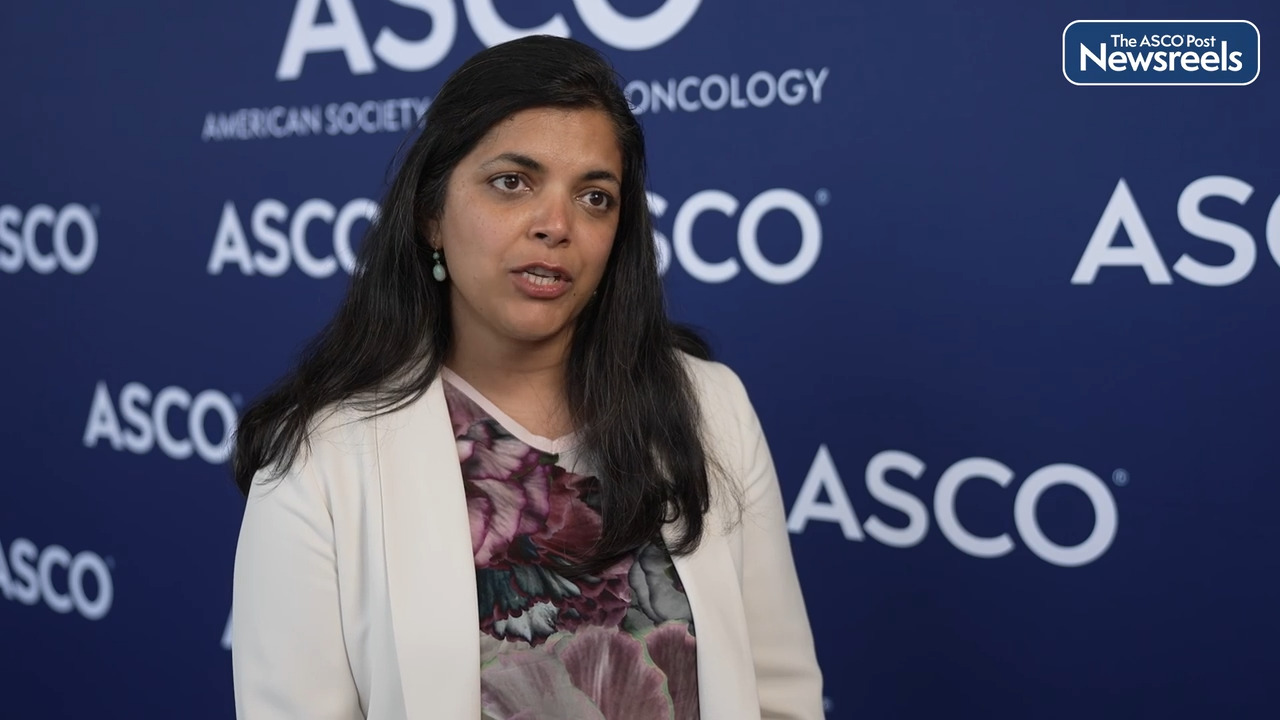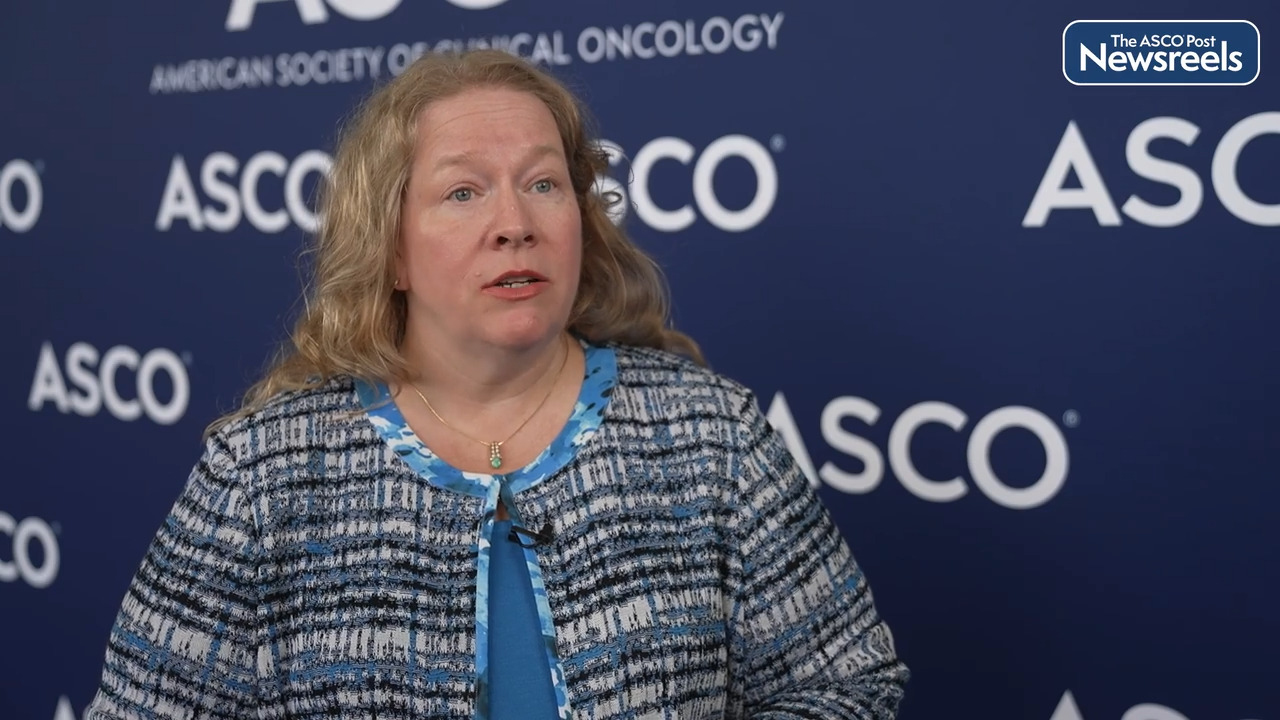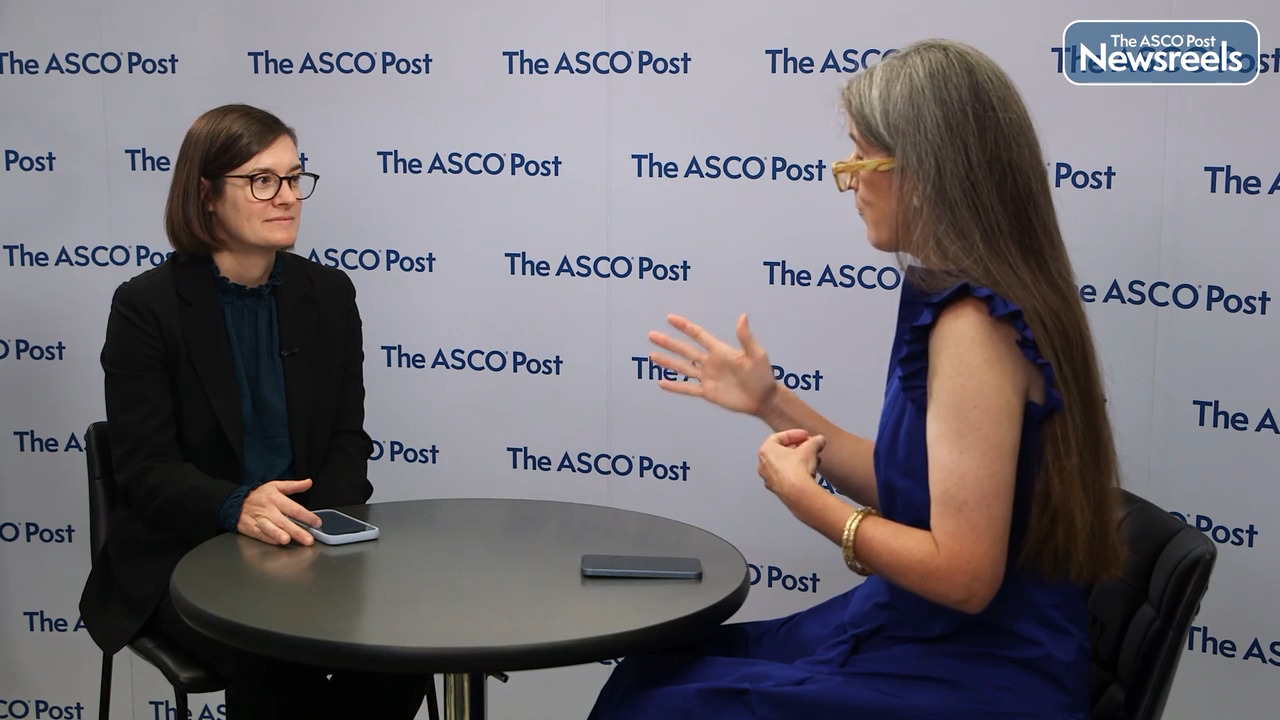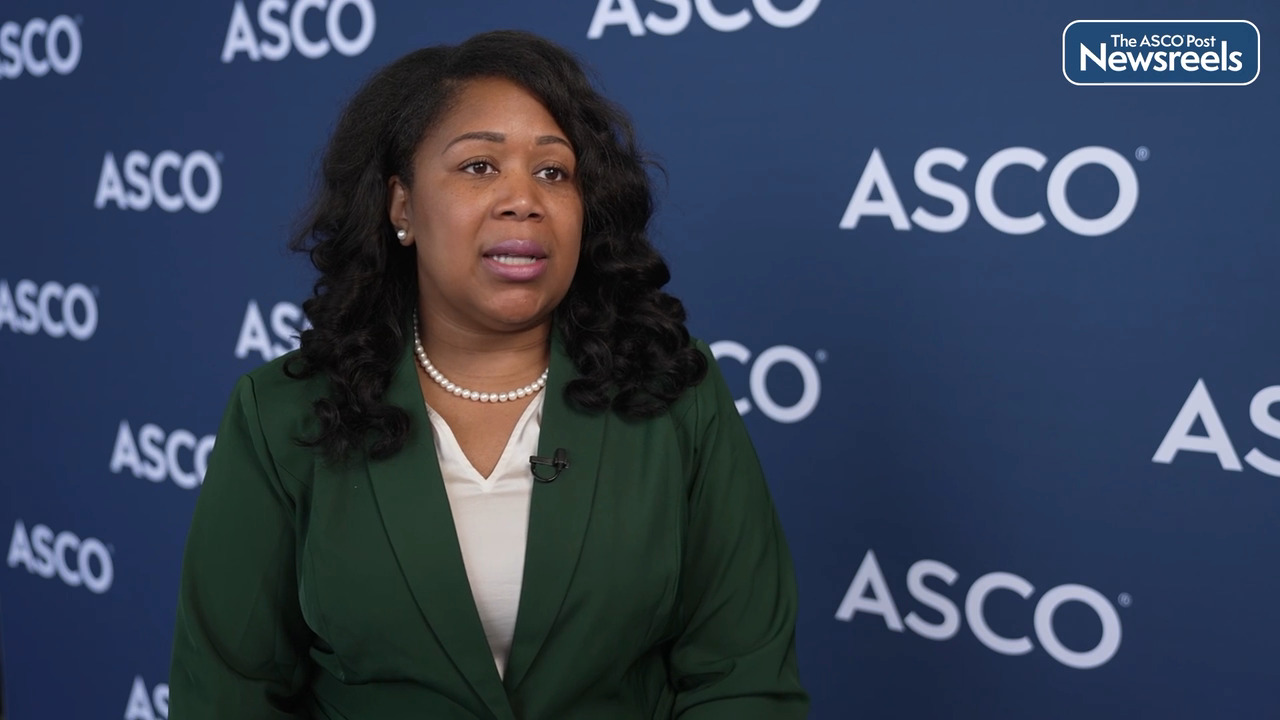Transcript
Disclaimer: This video transcript has not been proofread or edited and may contain errors.
Alicia K. Morgans, MD, MPH:
Hi, Karim. Thank you so much for joining me today. I'm excited to talk about TALAPRO-2, a really exciting presentation at ASCO.
Karim Fizazi, MD:
Thank you, Alicia. Very happy to discuss that with you.
Alicia K. Morgans, MD, MPH:
Wonderful. So can you set the stage a little bit and tell us the schema, because the data you presented was on a unique cohort that we have not really heard about yet.
Karim Fizazi, MD:
Yeah, that's correct. Actually, TALAPRO-2 is not a phase-3 trial. It's actually two different phase-3 trials, if you will. I'm saying that because we tested the same hypothesis, Talazoparib senza versus senza in really two different population of men. The first one was the all comer population, which was previously reported at ASCO GU with positive findings. But truly here at ASCO what we looked at are different men. So in other words, when we were done with the role in the first cohort, we carried on with accruing more patients, specifically having DNA repair defects. And we ended up to enroll a total of 400 men in the second cohort, which is the one I presented here at ASCO. So again, the design is the same for the two cohorts, but they're really kind of independent and it's alpha protected. So it's really not a sub analysis.
Alicia K. Morgans, MD, MPH:
Which is so important. And all of these men were similarly randomized though to the Enzalutamide plus or minus Talazoparib, right?
Karim Fizazi, MD:
Correct. And the primary endpoint was radiographic progression for survival. This was assessed by blind independent central review for this cohort with DNA repair defect. The trial is very clearly positive with a 55% prediction in the risk of progression or death faring obviously the Enzalutamide plus Talazoparib. So very clear difference for the primary endpoint. And we had a number obviously of secondary endpoints including overall survival, but also others.
Alicia K. Morgans, MD, MPH:
Wonderful. And I think that blinded internal central review so important for a radiographic progression endpoint. And you did say that the team had that, so this was very rigorously performed.
Karim Fizazi, MD:
Yes. And obviously this is because we want this treatment to go to the market if we can. So we need the rigor to be there so that the urgency can assess-
Alicia K. Morgans, MD, MPH:
Can accept it.
Karim Fizazi, MD:
Yes, they can accept that. Absolutely.
Alicia K. Morgans, MD, MPH:
Absolutely. So you mentioned other secondary endpoints, overall survival. I think there's also some quality of life data that has been discussed. Can you share some of that information?
Karim Fizazi, MD:
Of course.
So overall survival is really the key secondary endpoint. It's immature at this time. More than 75% of men are alive or were alive when we did the analysis. Still we see a clear trend favoring the combo with a 41% reduction in the risk of death, which is almost significant already now at the central analysis. We plan of course to do a final analysis, which will be even driven probably in about a year or so. But I'm quite confident given the shape of the Kaplan-Meier curves, that there is really a good chance that eventually this will be positive.
Alicia K. Morgans, MD, MPH:
Well, great. That'll be exciting too. And you also did some other exploratory analyses. Can you speak to those?
Karim Fizazi, MD:
Right. We also looked at time to PSA progression, which is so important.
Alicia K. Morgans, MD, MPH:
Absolutely.
Karim Fizazi, MD:
Psychologically to all patients where your patients and my patients really hate to see their PSA rising is devastating to them psychologically. The benefit is huge. It's really big. And Enzalutamide is a high bar regarding PSA.
Alicia K. Morgans, MD, MPH:
Absolutely.
Karim Fizazi, MD:
Drops in PSA progression. So this was not necessarily a given. It's really, really big difference there. Also the resist response was assessed and actually we also saw a clear and statistically meaningful difference with a 67% versus 40%. So it's really big. I'm not sure we have ever seen such a response rate in prostate cancer to be honest.
Alicia K. Morgans, MD, MPH:
Yeah.
Karim Fizazi, MD:
We also assessed PFS2. We also assessed times cytotoxic chemotherapy, which are all clearly improved favoring the talazo arm. So basically all efficacy endpoint tend to the same direction and actually are statistically different favoring the combo.
Alicia K. Morgans, MD, MPH:
What I think is important, you sort of alluded to this, but let's just say it just very, very clearly. This randomization was Enzalutamide, which is an extremely powerful and standard of care drug that we use in this first line MCRPC setting. It was Enzalutamide plus or minus Talazoparib.
Karim Fizazi, MD:
Correct.
Alicia K. Morgans, MD, MPH:
So, you were really going up against an active agent. This is not a study like some of our studies where we have randomization against a drug that is expected in some ways to fail.
Karim Fizazi, MD:
I fully agree. I mean, we know that Enzalutamide is a great drug. It's a well established standard of care for decay now. We are using it very often in this population of men. So again, the bar was high and I'm glad that we are able to report great data for efficacy.
Now, not all these patients are the same, obviously. We enroll in this cohort, patients with HRR alterations, but they are not the same. And we looked at this data on a gene by gene manner. So, basically first of course I'd like to comment about the BRCA patients. And here I have to say that the efficacy was quite impressive with an 80% reduction in the risk of progression or death.
A second inflammation, BRCA1 and BRCA2 patients seem to derive the same benefit from this combination. And I'm glad we saw that because I don't know what was your practice, but I know some colleagues were really wondering whether we should use the PARP inhibitor for BRCA1 patients.
Alicia K. Morgans, MD, MPH:
Absolutely.
Karim Fizazi, MD:
Yes. So that's really cool to have. Also, data for CDK 12 alterations, mostly biallelic mutations show, or suggest, that this combination is efficacious. The hazard ratio is around 0.4, and I think that's quite new. And those patients clearly require new treatments. That's typically aggressive cancers. Nothing works fantastically. So, if this is a true finding, that could really help with these patients. So this is why. And on the other hand, patients with ATM or CHEK2 alterations don't really seem to benefit. So I think that will be clinically helpful for decision making.
Alicia K. Morgans, MD, MPH:
I agree. It's interesting that your comment on BRCA1 because I think conversations have been similar in our practice. When we look at some exploratory analyses gene by gene with other PARP inhibitors used as single agents in prostate cancer, I think we haven't necessarily seen such a dramatic benefit in the BRCA1 patient population.
I mean, I think it's important to remember that those exploratory analyses are extremely underpowered. But it is also very encouraging that we see a signal in this particular study. And also for those CDK12 patients who sometimes we think about even using immunotherapy, we don't know what to do for these patients, maybe we're starting to figure it out.
Karim Fizazi, MD:
Absolutely. And you're right. I mean for CDK 12, we were hoping the immunotherapy to work. Actually it seems to work much less as compared to VMSI high patients, for example. So we're still waiting for new treatment for these men.
Alicia K. Morgans, MD, MPH:
Yes.
So if you had to sum this up and give us some perspective, because it's been a lot of TelePro two data over the last few months, what should we be thinking about? Where do we go from here in terms of TelePro two?
Karim Fizazi, MD:
Sure. No, I guess it's also important to remember that there's a cost to pay from a patient's perspective with those treatments. And we saw approximately 40% grade three and four anemia.
Which is not nothing. So it's really important to better understand who are the patients who benefit versus who are the adverse. Quality of life was significantly improved in vast population, which is to me, and I'm sure to you, knowing you, so important.
So I think for now, June 2023, I'm quite convinced that such a combination should have a clear future for patients with BRCA1, BRCA2 alterations. CDK 12, maybe. Now for the other HR alterations and also for patients without HR durations. I'm really on the fence because we do see RPFs benefit with a approximately 30% reduction. But it has to be balanced with a safety signal, we're also seeing. And probably longer term analysis are needed to see the true benefit we're providing to patients survival, yes or no, quality of life, yes or no, symptomatic improvement, yes or no. And then I feel more comfortable advising whether we should or not use such a combo in those men without BRCA alterations. So I think this is probably the most important thing we need to do for these men in let's say one or two coming years.
Alicia K. Morgans, MD, MPH:
Absolutely. One thing is clear, and that's that these BRCA patients have a poorer prognosis. And this may be an opportunity to really reign that in and to make an advance in a way that is both really efficacious and for the most part, at least according to the patient reported outcomes, probably tolerable to the patients.
Karim Fizazi, MD:
Agreed.
Alicia K. Morgans, MD, MPH:
Work to be done in understanding how to really use this combination across that spectrum of patients if we end up doing that or not. And a lot for us to learn. But I sincerely appreciate your time and sharing this information with us today.
Karim Fizazi, MD:
My pleasure. Thank you.





